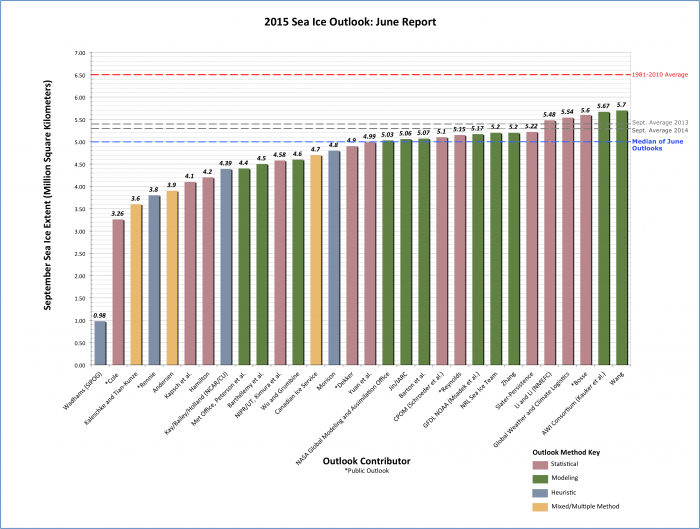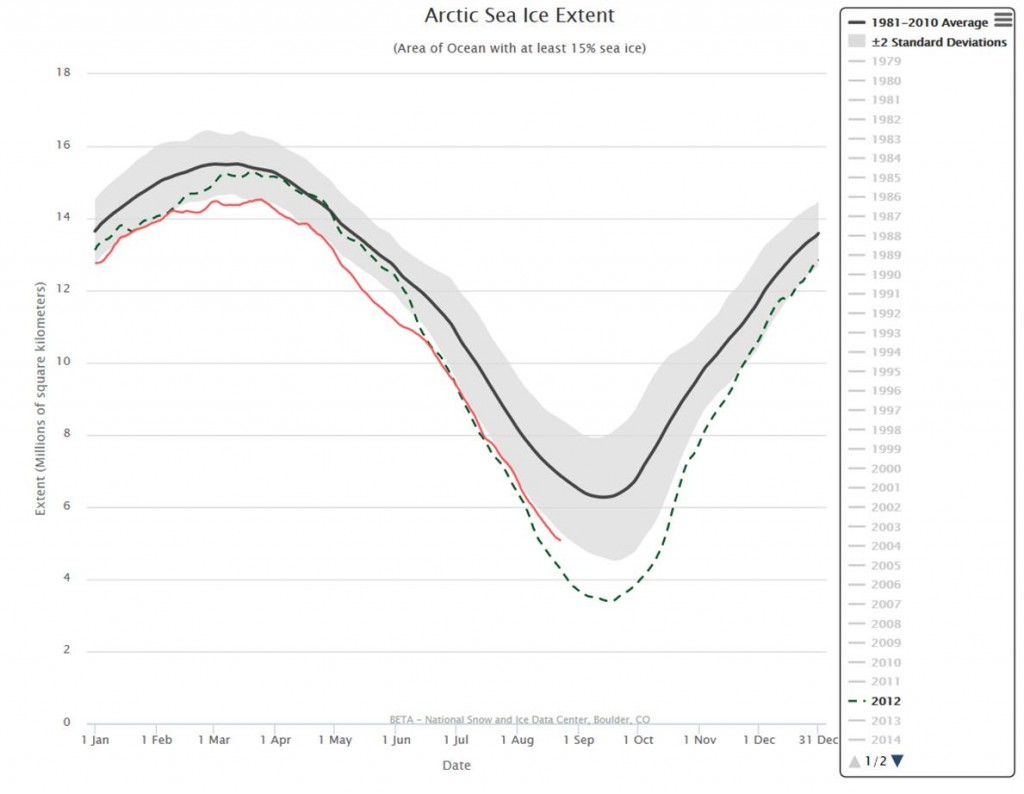Vor gut zwei Monaten warnte die Neue Zürcher Zeitung am 14. Juni 2016 vor einer unmittelbar bevorstehenden Rekordschmelze des arktischen Meereises:
Rekord-Eisschmelze in der Arktis: «Hitzewelle» auf Grönland
Das arktische Meereis steuert auf ein neues Sommer-Minimum zu. Das Verschwinden der polaren Eisdecke kann einschneidende klimatische Prozesse in Gang setzen. Das arktische Eis schmilzt derzeit rascher als im bisherigen Rekordjahr 2012. Laut Daten des amerikanischen Snow and Ice Data Center (NSIDC) war in diesem Mai die Eisfläche des Polarmeers (ganz gefroren oder mit einem Eisanteil von mindestens 15 Prozent) um 580 000 Quadratkilometer kleiner als noch 2004; das entspricht rund der Fläche Frankreichs. Die Meereis-Gesamtfläche belief sich noch auf 12 Millionen Quadratkilometer oder etwa das Anderthalbfache der Landmasse Australiens. Neues Minimum absehbarWeiterlesen in der Neuen Zürcher Zeitung
War der Alarm gerechtfertigt? Wir schauen uns hierzu die offiziellen Daten des NSIDC an (Abbildung 1). Die gestrichelte grüne Linie gibt die Eisfläche für das bisherige Rekordschmelzjahr 2012 an, die rote Linie steht für 2016. In der ersten Hälfte des Jahres war der Schmelzvorgang in der Tat auf Rekordkurs. Im Juli (2016) jedoch verlangsamte sich das Schmelzen. Fakt ist: Seit Juli 2016 gibt es sehr viel mehr Eis als zum gleichen Zeitpunkt 2012. Im September gibt es dann die Endabrechnung, wenn typischerweise das Minimum erreicht wird.
Abbildung 1: Arktische Meerausdehnung. Die gestrichelte grüne Linie gibt die Eisfläche für das bisherige Rekordschmelzjahr 2012 an, die rote Linie steht für 2016. Quelle: NSIDC
Die NASA gab am 19. August 2016 per Pressemitteilung das „Scheitern“ des diesjährigen Schmelzrekordes bekannt:
NASA Monitors the ‚New Normal‘ of Sea Ice
This year’s melt season in the Arctic Ocean and surrounding seas started with a bang, with a record low maximum extent in March and relatively rapid ice loss through May. The melt slowed down in June, however, making it highly unlikely that this year’s summertime sea ice minimum extent will set a new record. “Even when it’s likely that we won’t have a record low, the sea ice is not showing any kind of recovery. It’s still in a continued decline over the long term,” said Walt Meier, a sea ice scientist at NASA’s Goddard Space Flight Center in Greenbelt, Maryland. “It’s just not going to be as extreme as other years because the weather conditions in the Arctic were not as extreme as in other years.” “A decade ago, this year’s sea ice extent would have set a new record low and by a fair amount. Now, we’re kind of used to these low levels of sea ice – it’s the new normal.”
This year’s sea ice cover of the Barents and Kara seas north of Russia opened up early, in April, exposing the surface ocean waters to the energy from the sun weeks ahead of schedule. By May 31, the extent of the Arctic sea ice cover was comparable to end-of-June average levels. But the Arctic weather changed in June and slowed the sea ice loss. A persistent area of low atmospheric pressure, accompanied by cloudiness, winds that dispersed ice and lower-than-average temperatures, didn’t favor melt.
The rate of ice loss picked up again during the first two weeks of August, and is now greater than average for this time of the year. A strong cyclone is moving through the Arctic, similar to one that occurred in early August 2012. Four years ago, the storm caused an accelerated loss of ice during a period when the decline in sea ice is normally slowing because the sun is setting in the Arctic. However, the current storm doesn’t appear to be as strong as the 2012 cyclone and ice conditions are less vulnerable than four years ago, Meier said.
Kurioserweise brachte die britische Tageszeitung The Guardian einen Tag zuvor (18.8.2016) einen Beitrag, in dem von einer „Todesspirale“ der arktischen Meereisschmelze fabuliert wird:
Time to listen to the ice scientists about the Arctic death spiral
The Arctic’s ice is disappearing. We must reduce emissions, fast, or the human castastrophe predicted by ocean scientist Peter Wadhams will become reality […] Because Wadhams says what other scientists will not, he has been widely slandered, attacked and vilified by denialists and politicians who have advised caution or non-action. But now he returns their fire, exhorting people to counter what he calls “the sewage flow of lies and deceit” emitted by the deniers. Above all, he says, people who study climate change should speak up and be prepared to risk the blighting of their careers and absence of honours. But he joins other climate researchers to cross lines that the public may still find unacceptable. He wants global action to find new ways to remove carbon from the atmosphere, and is not afraid of nuclear power – both of which answers can be swallowed – but he also argues for a colossal, global research programme in geo- engineering. […]
Eine seltsame „Todesspirale“, bei der es seit 4 Jahren keine Steigerung der Schmelze gegeben hat. Auch die Mahnung, man solle viel stärker auf den Eisforscher Peter Wadhams hören ist eher belustigend, wenn man sich die Prognoseleistung des klimaalarmistisch veranlagten Wissenschaftlers genauer betrachtet. In der folgenden Graphik sind 30 verschiedene Schätzungen zum arktischen Meereisminimum aufgetragen, die vor Beginn der Schmelzsaison abgegeben wurden (Abbildung 2). Ergebnis: Peter Wadhams liegt mit viel Abstand an letzter Stelle, haute mit seinen Zahlen meilenweit am realen Wert von 4,5 Millionen km2 vorbei. Peinlich. Und auf diesen Wadhams soll man nun verstärkt hören?

Abbildung 2: Schätzungen des arktischen Meereisminimums 2015 von 30 verschiedenen Wissenschaftlergruppen. Quelle: SIPN.
Fachkollege Ed Hawkins von der University of Reading zeigte sich entsetzt, wie der Guardian diese wissenschaftliche Außenseiterposition so aufbauschen konnte. Per Twitter machte er seinem Ärger Luft:
Es erstaunt nicht, dass der fachlich am Rande des wissenschaftlichen Spektrums agierende Wadhams gerne gemeinsame Sache mit dem nicht minder extremen Potsdam-Institut für Klimafolgenforschung (PIK) macht. Unter anderem taucht Wadhams in einer gemeinsamen Publikation mit Anders Levermann auf, der zum harten Kern der PIK-Klimaalarm-Gruppe gehört.





